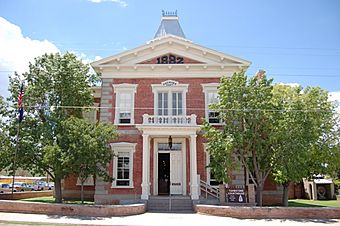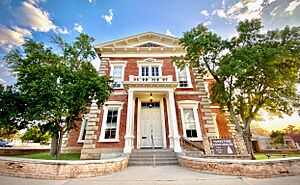Tombstone Courthouse State Historic Park facts for kids
Quick facts for kids |
|
|
Tombstone Courthouse
|
|

Former Cochise County Courthouse, now site of Tombstone Courthouse State Historic Park
|
|
| Location | Tombstone, Arizona |
|---|---|
| Built | 1882 |
| Visitation | 40,105 (2022) |
| NRHP reference No. | 72000196 |
| Added to NRHP | April 13, 1972 |
Tombstone Courthouse State Historic Park is a special state park in Arizona, United States. It's located in the famous town of Tombstone. This park protects the original building that served as the Cochise County courthouse.
This two-story building was built in 1882. It has a unique cross shape and was designed in the Victorian style. Inside, it held many important offices like the sheriff's office, courtrooms, and even a jail. Today, the courthouse is a museum. It's filled with interesting items that tell the story of Tombstone's exciting past. Outside, you can see a replica of a gallows in the courtyard. This marks the spot where people were once punished for serious wrongdoings.
The Tombstone Courthouse was one of Arizona's first state parks. It was also the very first park to open in 1959 after the Arizona State Parks Board was created in 1957.
Contents
The Story of Tombstone's Courthouse
How Tombstone Grew into a Busy Town
The story of Tombstone began in 1877. A prospector named Ed Schieffelin discovered silver ore in southeastern Arizona. Soon, many miners rushed to the area, hoping to find their own fortunes. This led to the founding of the town of Tombstone.
Tombstone quickly grew into a busy place. By 1881, over 7,000 people lived there. At first, this area was part of Pima County. The county seat, Tucson, was a long, difficult journey away. Miners and merchants had to travel 150 miles roundtrip to Tucson. They needed to record important documents like mining claims and property deeds.
Creating Cochise County and Building the Courthouse
Because of the long travel, Tombstone residents wanted their own county. In 1881, they voted to separate from Pima County. The state legislature then created a new county called Cochise County. Tombstone became the main city, or "county seat," for this new county.
A brand new courthouse was built in 1882. It held all the county's offices. The Sheriff of Cochise County had his office on the ground floor. This courthouse helped bring law and order to the growing town. It gave people a proper place to solve problems in court instead of on the streets.
The Courthouse After Tombstone's Boom Years
Tombstone remained the county seat until 1929. By then, the nearby town of Bisbee had grown larger. The county seat was moved to Bisbee. The last county office left the Tombstone Courthouse in 1931.
The building was empty for many years. There was a brief attempt to turn it into a hotel in the 1940s, but it didn't work out. In 1955, the Tombstone Restoration Commission took over the building. They began to fix it up and turn it into a historical museum. Since 1959, it has been a state park. It continues to share Tombstone's exciting history through exhibits and thousands of artifacts.
Courthouse Design and Style
What Makes the Building Special
The Tombstone Courthouse is a beautiful example of "Territorial Victorian" architecture. This style was popular in Arizona during its early days as a territory. The building is elegant and well-designed. It was one of the largest buildings in Arizona Territory when it was built. It is also the oldest courthouse still standing in Arizona.
The main part of the courthouse was built in 1882. It cost about $50,000, which was a lot of money back then! A small addition was built at the back in 1904.
Key Features of the Courthouse
The building is made of red brick. It has white stone details that separate the lower and upper parts. A small tower, called a cupola, sits on top with a fancy roof. This tower has a decorative cresting that looks like a "widow's walk."
The windows are tall and have heavy frames. The roofline has decorative elements called dentils. Inside, there used to be chimneys for every room, but now only two remain. An iron spiral staircase leads up to the courtroom.
The front entrance has a porch supported by four square pillars. The courthouse was added to the National Register of Historic Places in 1972. This means it's recognized as an important historical site.
More to Explore
- Gunfight at the O.K. Corral
- Bisbee Massacre
- Shootout at Wilson Ranch
Images for kids










